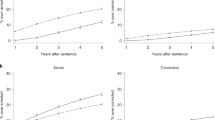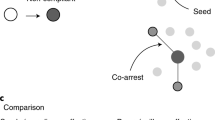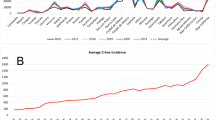Abstract
We estimate causal peer effects in police misconduct using data from about 35,000 officers and staff from London’s Metropolitan Police Service for the period 2011–2014. We use instrumental variable techniques and exploit the variation in peer misconduct that results when officers switch peer groups. We find that a 10% increase in prior peer misconduct increases an officer’s later misconduct by 8%. As the police are empowered to enforce the law and protect individual liberties, integrity and fairness in policing are essential for establishing and maintaining legitimacy and public consent1,2,3,4,5. Understanding the antecedents of misconduct will help to develop interventions that reduce misconduct.
This is a preview of subscription content, access via your institution
Access options
Access Nature and 54 other Nature Portfolio journals
Get Nature+, our best-value online-access subscription
$29.99 / 30 days
cancel any time
Subscribe to this journal
Receive 12 digital issues and online access to articles
$119.00 per year
only $9.92 per issue
Buy this article
- Purchase on Springer Link
- Instant access to full article PDF
Prices may be subject to local taxes which are calculated during checkout


Similar content being viewed by others
Data availability
The data that support the findings of this study are not publicly available. If you would like to view and reproduce our results, please contact E.G.Q.-T. to organize a supervised visit to our local network.
Code availability
Analyses were conducted in R 3.4.5 and Stata 13.1. All code is available in the public repository https://github.com/edikaQT/misconduct_peer_effects.
Change history
12 June 2019
An amendment to this paper has been published and can be accessed via a link at the top of the paper.
References
Goldsmith, A. Police reform and the problem of trust. Theor. Criminol. 9, 443–470 (2005).
Ivkovic, S. K. & Haberfeld, M. R. Special issue on police integrity: an introduction. Polic. Int. J. 39, 246–431 (2016).
Bayley, D. H. Law enforcement and the rule of law: is there a tradeoff? Criminol. Public Policy 2, 133–154 (2002).
Walker, S. E. & Archbold, C. A. The New World Of Police Accountability (Sage Publications, 2013).
Murphy, K., Hinds, L. & Fleming, J. Encouraging public cooperation and support for police. Polic. Soc. 18, 136–155 (2008).
Christopher, W. Report of the Independent Commission on the Los Angeles Police Department (Diane Publishing, 1991).
Gillard, M. & Flynn, L. Untouchables: Dirty Cops, Bent Justice and Racism in Scotland Yard (A&C Black, 2012).
UK Government Select Committee on Home Affairs First Report https://publications.parliament.uk/pa/cm199798/cmselect/cmhaff/258-i/ha0103.htm (House of Commons, 1998).
Harris, C. J. Problem officers? Analyzing problem behavior patterns from a large cohort. J. Crim. Justice 38, 216–225 (2010).
Kane, R. J. & White, M. D. Bad cops: a study of career-ending misconduct among New York City police officers. Criminol. Public Policy 8, 737–769 (2009).
Lersch, K. M. & Mieczkowski, T. Who are the problem-prone officers? An analysis of citizen complaints. Am. J. police 15, 23–44 (1996).
Brandl, S. G., Stroshine, M. S. & Frank, J. Who are the complaint-prone officers? An examination of the relationship between police officers’ attributes, arrest activity, assignment, and citizens’ complaints about excessive force. J. Crim. Justice 29, 521–529 (2001).
McElvain, J. P. & Kposowa, A. J. Police officer characteristics and internal affairs investigations for use of force allegations. J. Crim. Justice 32, 265–279 (2004).
Harris, C. J. Exploring the relationship between experience and problem behaviors: a longitudinal analysis of officers from a large cohort. Police Q. 12, 192–213 (2009).
Kappeler, V. E., Sapp, A. D. & Carter, D. L. Police officer higher education, citizen complaints and departmental rule violations. Am. J. Police 11, 37 (1992).
Harris, C. J. The onset of police misconduct. Polic.: Int. J. Police Strateg. Manag. 37, 285–304 (2014).
Donner, C. M. & Jennings, W. G. Low self-control and police deviance: applying Gottfredson and Hirschi’s general theory to officer misconduct. Police Q. 17, 203–225 (2014).
Pogarsky, G. & Piquero, A. R. Studying the reach of deterrence: can deterrence theory help explain police misconduct? J. Crim. Justice 32, 371–386 (2004).
Brooks, L.W. Police discretionary behavior: A study of style. Critical Issues In Policing: Contemporary Readings 7th edn (eds. Dunham, R. G. & Alpert, G. P.) 122–142 (Waveland Press, 2015).
Wolfe, S. E. & Piquero, A. R. Organizational justice and police misconduct. Crim. Justice Behav. 38, 332–353 (2011).
Engel, R. S. The effects of supervisory styles on patrol officer behavior. Police Q. 3, 262–293 (2000).
Engel, R. S. How police supervisory styles influence patrol officer behavior. Critical Issues In Policing: Contemporary Readings 7th edn (eds. Dunham, R. G. & Alpert, G. P.) 219–228 (Waveland Press, 2015).
Terrill, W. & Reisig, M. D. Neighborhood context and police use of force. J. Res. Crime Delinquency 40, 291–321 (2003).
Kohlberg, L. Stage and Sequence: the Cognitive–Developmental Approach to Socialization (Rand McNally, 1969).
Treviño, L. K., Den Nieuwenboer, N. A. & Kish-Gephart, J. J. Unethical behavior in organizations. Annu. Rev. Psychol. 65, 635–660 (2014).
Mas, A. & Moretti, E. Peers at work. Am. Econ. Rev. 99, 112–145 (2009).
Zimmerman, D. J. Peer effects in academic outcomes: evidence from a natural experiment. Rev. Econ. Stat. 85, 9–23 (2003).
Trogdon, J. G., Nonnemaker, J. & Pais, J. Peer effects in adolescent overweight. J. Health Econ. 27, 1388–1399 (2008).
Herbst, D. & Mas, A. Peer effects on worker output in the laboratory generalize to the field. Science 350, 545–549 (2015).
Ingram, J. R., Paoline, E. A. III & Terrill, W. A multilevel framework for understanding police culture: the role of the workgroup. Criminology 51, 365–397 (2013).
Chappell, A. T. & Piquero, A. R. Applying social learning theory to police misconduct. Deviant Behav. 25, 89–108 (2004).
Getty, R. M., Worrall, J. L. & Morris, R. G. How far from the tree does the apple fall? Field training officers, their trainees, and allegations of misconduct. Crime Delinquency 62, 821–839 (2016).
Manski, C. F. Identification of endogenous social effects: the reflection problem. Rev. Econ. Stud. 60, 531–542 (1993).
Terrill, W. & Ingram, J. R. Citizen complaints against the police: an eight city examination. Police Q. 19, 150–179 (2016).
Prenzler, T. & Ransley, J. Police Reform: Building Integrity (Hawkins Press, 2002).
Angrist, J. D. The perils of peer effects. Labour Econ. 30, 98–108 (2014).
Manski, C. F. Economic analysis of social interactions. J. Econ. Perspect. 14, 115–136 (2000).
Staiger, D. & Stock, J. H. Instrumental variables regression with weak instruments. Econometrica 65, 557–586 (1997).
Hansen, L. P. Large sample properties of generalized method of moments estimators. Econometrica 50, 1029−1054 (1982).
Klockars, C. B., Ivkovich, S. K., Harver, W. E. & Haberfeld, M. R. The Measurement of Police Integrity (National Institute of Justice, 1997).
Lersch, K. M. Are citizen complaints just another measure of officer productivity? An analysis of citizen complaints and officer activity measures. Police Pract. Res. 3, 135–147 (2002).
Ashforth, B. E. & Anand, V. The normalization of corruption in organizations. Res. Organ. Behav. 25, 1–52 (2003).
Loree, D. Corruption in Policing: Causes and Consequences - A Review of the Literature. (Research and Evaluation, Community, Contract and Aboriginal Policing Services Directorate, Royal Canadian Mounted Police, 2006).
Hough, M., May, T., Hales, G. & Belur, J. Misconduct by police leaders in England and Wales: an exploratory study. Polic. Soc. 28, 541–552 (2018).
Akers, R. L. Criminological Theories: Introduction and Evaluation (Routledge, 2013).
Acknowledgements
This work was supported by Economic and Social Research Council grants ES/K002201/1, ES/P008976/1, ES/N018192/1 and Leverhulme Trust grant RP2012-V-022. The funders had no role in study design, data collection and analysis, decision to publish or preparation of the manuscript.
Author information
Authors and Affiliations
Contributions
Data were provided by the Metropolitan Police Service to N.S. The concept for the paper was developed jointly by the authors. E.G.Q.-T. designed and completed all the analysis and wrote the manuscript of the paper. Both authors revised the manuscript and approved the final version.
Corresponding authors
Ethics declarations
Competing interests
The authors declare no competing interests.
Additional information
Publisher’s note: Springer Nature remains neutral with regard to jurisdictional claims in published maps and institutional affiliations.
Supplementary information
Supplementary Information
Supplementary Methods, Supplementary Figures 1 and 2, Supplementary Tables 1–13 and Supplementary References.
Rights and permissions
About this article
Cite this article
Quispe-Torreblanca, E.G., Stewart, N. Causal peer effects in police misconduct. Nat Hum Behav 3, 797–807 (2019). https://doi.org/10.1038/s41562-019-0612-8
Received:
Accepted:
Published:
Issue Date:
DOI: https://doi.org/10.1038/s41562-019-0612-8



